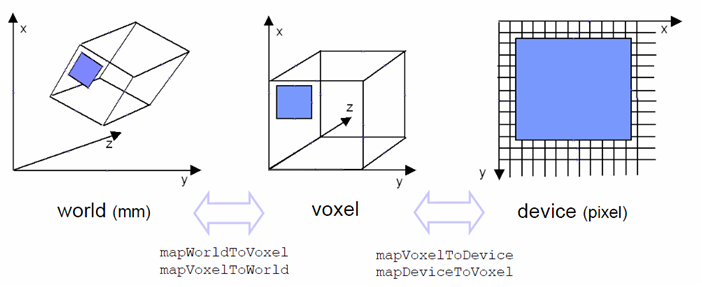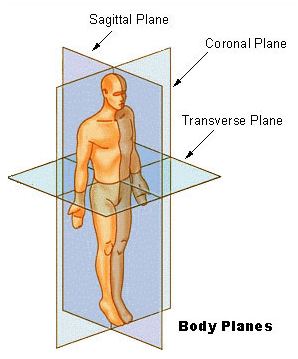DICOM
Example 1: Data import in MeVisLab
Example 1: Data Import in MeVisLab
MeVisLab provides several pre-defined modules to import data for processing in your networks.
These chapters explain the data formats and modules related to this example:
Example 1.1: MeVisLab Coordinate Systems
Example 1.1: MeVisLab Coordinate Systems
Three coordinate systems exist next to each other:
- World coordinates
- Voxel coordinates
- Device coordinates
World coordinate systems in MeVisLab are always right handed.
The blue rectangle shows the same region in the three coordinate systems.

World coordinates
World coordinates are:
- Global: Combine several objects in a view
- Isotropic: All directions are equivalent
- Orthogonal: Coordinate axes are orthogonal to each other
The origin of the world coordinate system can be anywhere and is not clearly defined. Origins of the other coordinate systems can always be mapped to the world coordinate system. In case of DICOM images, this mapping is defined by DICOM tags.
Example 1.2: DICOM Coordinate Systems
Example 1.2: DICOM Coordinate Systems
General
Coordinate systems in DICOM are basically the same as world coordinates in MeVisLab (except for the 0.5 voxel offset). World coordinates also refer to the patient axes. They are:
- Based on the patient’s main body axes (transverse, coronal, sagittal)
- Measured as 1 coordinate unit = 1 millimeter
- Right-handed
- Not standardized regarding their origin

Example 6: DICOM RT Visualization in MeVisLab – RTSTRUCT and RTDOSE Workflow
Example 6: DICOM RT Visualization in MeVisLab – RTSTRUCT and RTDOSE Workflow
Introduction
This tutorial explains how to load and visualize DICOM RT (Radiotherapy) data in MeVisLab. You will learn how to:
- Load CT and related RTSTRUCT data.
- Visualize RTSTRUCTs as colored CSOs.
- Show labels next to each RTSTRUCT contour.
- Visualize RTDOSE as a semi-transparent colored overlay.
DICOM RT files are essential in radiotherapy treatment planning.
They include:
- RT Structure Set, containing information related to patient anatomy, for example structures, markers, and isocenters. These entities are typically identified on devices such as CT scanners, physical or virtual simulation workstations, or treatment planning systems.
- RT Plan, containing geometric and dosimetric data specifying a course of external beam and/or brachytherapy treatment, for example beam angles, collimator openings, beam modifiers, and brachytherapy channel and source specifications. The RT Plan entity may be created by a simulation workstation, and subsequently enriched by a treatment planning system before being passed on to a record and verify system or treatment device. An instance of the RT Plan object usually references an RT Structure Set instance to define a coordinate system and set of patient structures.
- RT Dose, containing dose data generated by a treatment planning system in one or more of several formats: three-dimensional dose data, isodose curves, DVHs, or dose points.
Additional objects not used in this tutorial are:


